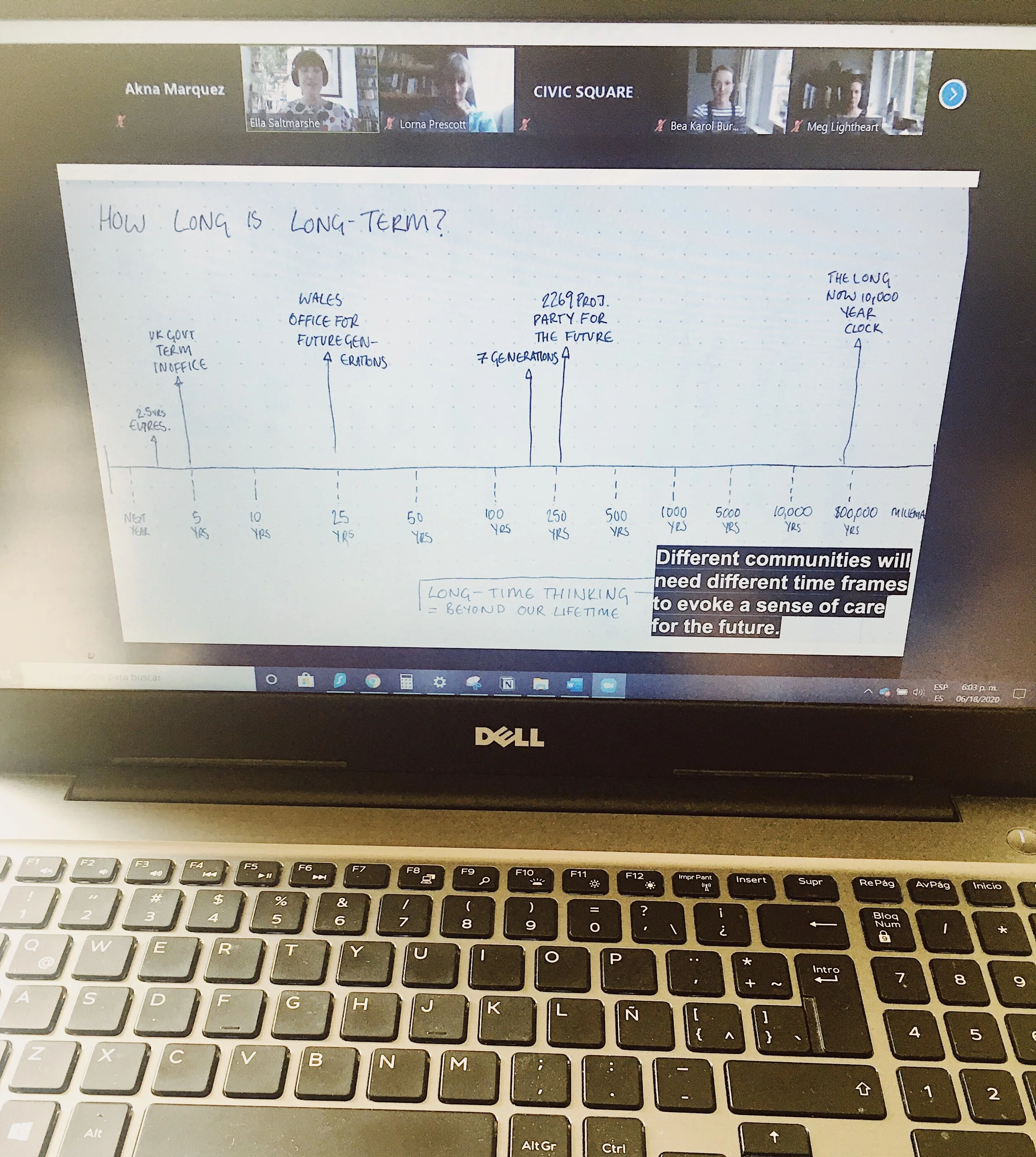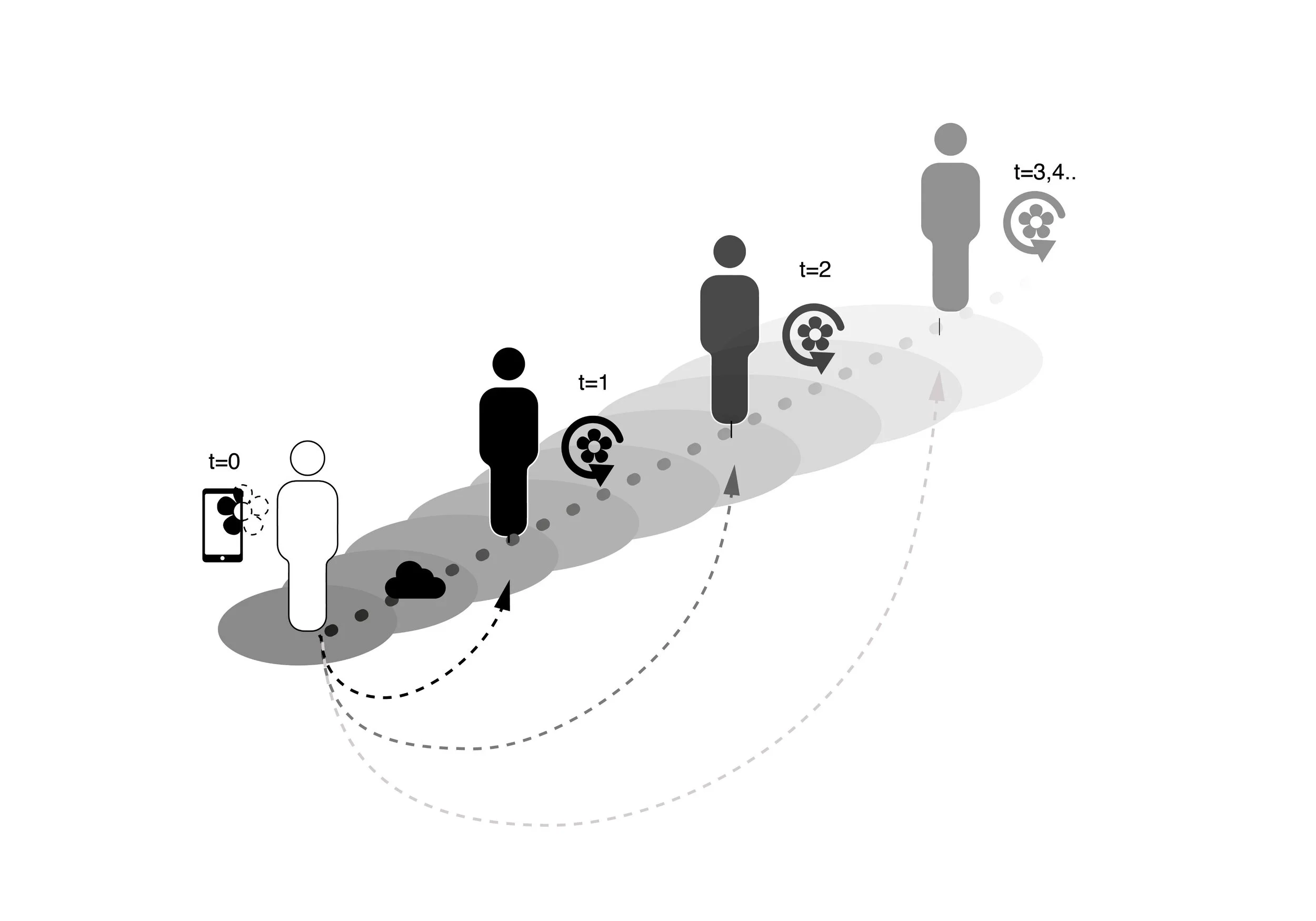The (pandemic imposed) slow pace of this year has carved a space to reflect on how we make sense of time. Our frenetic lifestyle is regularly filled with numerous daily tasks and decisions that keep us busy, making it easy to get caught into narrow, short-term thinking.
But…
what do our lives contribute to in the long run?
In the past month, I participated in a virtual workshop hosted by Bea Karol Burks and Ella Saltmarshe, during the Re_Festival event (organized by CIVIC SQUARE), with the focus of “Creating the Long Time”. The session inspired rumination in me (and perhaps in many of the participants) and led me to write this post based on my notes.
Picture I took during the virtual event “Creating the Long Time”.
One of the key takeaways I got from the event was learning to see a wider time span for understanding and designing our impact as communities, based on two concepts:
Long-termism: planning and forecasting for the future.
Long-timism: cultivating care for the world beyond our lifetimes.
While as designers we probably already gravitate towards imagining what the future may look like, using forecasting as a tool to conceptualize and predict trends, we rarely make creative decisions that extend beyond a few years, much less a lifetime period.
“In politics, the dominant time frame is a term of office, in fashion and culture, it’s a season. For corporations it’s a quarter, on the internet it’s minutes, and on the financial markets mere milliseconds”
Our wealth and rights, as individuals, depend on the efforts and achievements of the many generations who came before us. However, we tend to underestimate our relationships and lineages with past generations and future populations.
This may be caused by a “systemic and psychological inability”[1] to see beyond immediate consequences and results, as well as the difficulty to understand our lasting footprint beyond our deaths (which may be caused by a refusal of death itself).
We may suffer from a limited “human-centric” view of the world (which is why many creatives are already pushing towards a planet-centric view of design over the popular human-centered design model). Homo sapiens represent just a fraction of history, and of the creatures that have been (and will be) alive on this planet.
Promotional video for the book "The Good Ancestor: How to Think Long Term in a Short-Term World" by the philosopher Roman Krznaric (2020).
From Krznaric’s video for the book (which I haven’t read yet but it’s on my wish list), I loved the idea of passing on gifts for future generations.
It’s hard to grasp the immensity of time but we could use different references to project scenarios that help us to expand our thinking (such as a dear person’s grandchild, which starts from someone you already know and care about).
We could also learn from indigenous cultures with worldviews that connect their communities to long lineages, creating a sense of responsibility to care for the future of their descendants, and thanking their ascendants for what they have given them.
Even trying to shift beyond short time spans and immediate gratifications in benefit of medium to longer-term impacts in our own lifetime could be a start (in general, I try to apply ideas in a gradual manner and it works for me; if I can’t think about time a couple of months or years in the future, I’ll hardly adopt the custom of seeing decades or centuries from now).
In my personal life, I like to think about how to make thoughtful decisions and actions in the present that will make the life of my future self better. It can be small things like cooking ahead yummy food that “future Akna” will enjoy next week or getting a letter from “past Akna”, all the way to finding the motivation to invest, exercise and stay healthy in the present, which I hope will allow me to enjoy life and be active and present for my loved ones in future decades.
From The Good Ancestor (2020). Graphic by Nigel Hawtin.
In a longer span, initiatives such as the Rights for Future Generations, are attempting to advance environmental protections for future populations in relation to the climate crisis. Others are trying to imagine how can we construct post-mortem interactions with these future generations, like the concept of Willed Futures, a platform that automates acts of care that transcend death.
Users are able to send a flower every year to a loved one after the moment of passing, extending the presence of self-hood well beyond bodily material decay, by digitally coding and planning gestures of generosity that are executed in the afterlife.
Valuing the long-term is about understanding our place in the wider web of life: [2]
Caring about the richness of life on Earth and its evolution during the geological history of the universe (Deep time)
Developing a connection to future and past generations (Multigenerational emotions)
Respecting the value of nature and non-human species of Earth (Interconnected worldviews).
Dealing with the fact that our lives will end and facing this reality by living more intentionally (Mortality consciousness).
Building the desire and agency to leave a positive legacy (Legacy stance).
These are key mentalities (presented in the workshop) through which we can live our lives and reframe our relationship with time. We need to develop the will, motivation and instruments to escape the prominence of the present, and realize our power and responsibility for the future.
What things could we do now, that would bring benefits in the long-time future? What strategies can you think of to extend our time horizons?
Footnotes:
EIT Climate KIC. (2020) Persistent selves. Retrieved from: https://www.climate-kic.org/opinion/persistent-selves/
Summary from my notes of the event “Creating the Long Time”. The namings in bold and brackets for each idea was presented by the workshop hosts: Bea Karol Burks and Ella Saltmarshe (2020).




